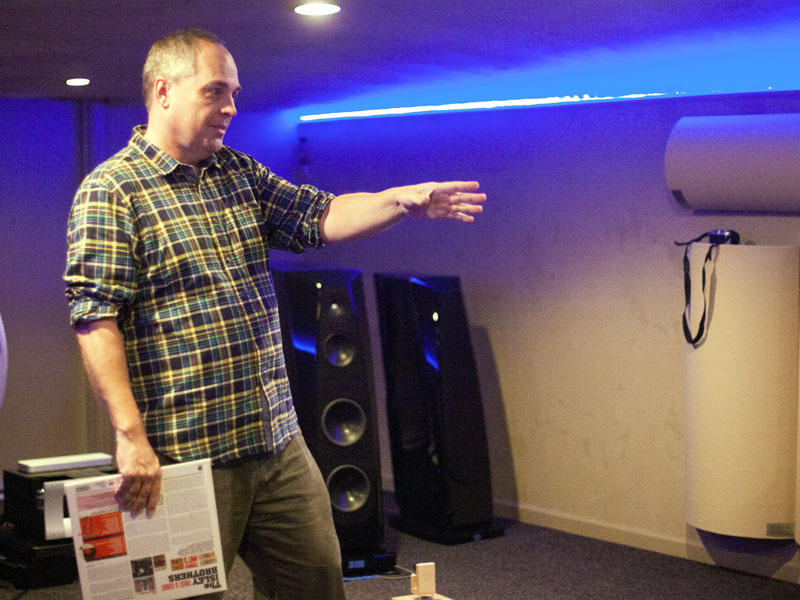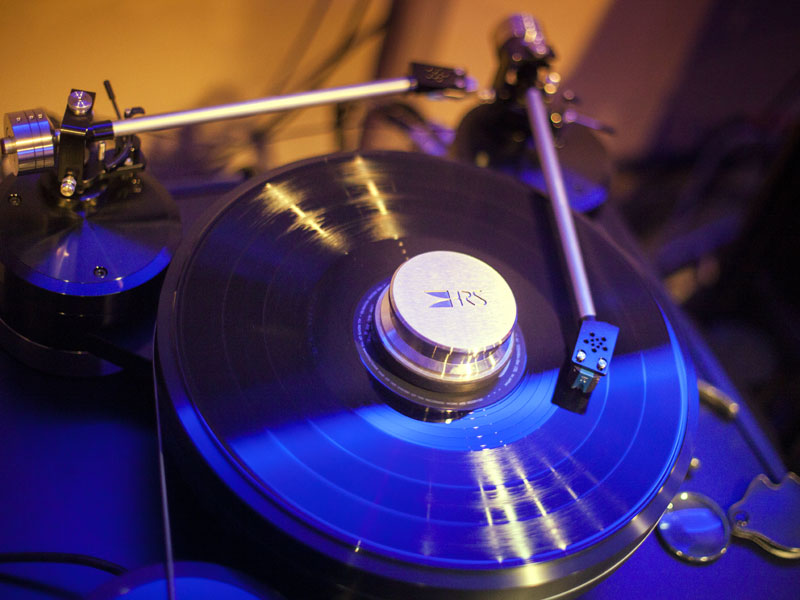Don't
Fear This Spyder
ate November brought the resumption of the Spin Parties hosted by Analog Audio of Minnesota and co-sponsored by The Audio Beat. There was a special guest this time: Andrea Brinkmann of Germany's Brinkmann Audio, who was on hand to debut her firm's new Spyder turntable. These informal get-togethers, held about three times a year, are literally about the music -- listening to it and understanding it better. Paul Blizel of Analog Audio (below) may be an audio dealer, but he's also an LP collector with an astute ear (and huge collection), and hearing his system, housed in a purpose-built ground-floor listening bunker, is always a treat.
The Spyder ($14,000) is a plinthless design that can accommodate up to four 9"-12" tonearms. Each 'arm can be mounted on its own independent sub-base, or "jig" in Brinkmann terminology, and up to four of these jigs can be attached to the turntable's base, which contains Brinkmann's trademark hydrostatic bearing and attachment points for the jigs. The base itself is as minimalist as is compatible with both resonance control and sound mechanical design. The straightforwardness and effectiveness of this modular approach were demonstrated by Andrea, and it took her only a few short minutes to install a second 10.5 'arm ($6300 each) on the resident Spyder, which carried a Lyra Kleos mono cartridge ($3500); the other had a Brinkmann Pi cartridge ($2700) mounted for stereo playback. This capability will render the newest Brinkmann 'table a boon to those who like to use multiple 'arm/cartridge combinations. Jigs are an additional $3000 each.
The Spyder is a belt-drive design, featuring a Sinus four-phase, twelve-pole motor and a 22-pound aluminum/crystal platter, and it is made to exactly the level of refinement and sophistication one expects from a German-made precision instrument. While it comes with a solid-state power supply, one can upgrade to the RoNt II tubed power supply ($4300). Flexibility is an integral part of the Spyder's DNA. Besides the debut of the Spyder, the other focus of the gathering was a fascinating comparison between mono and stereo versions of well-known classic recordings, among them the Beatles' In Mono and In Stereo boxed sets, as well as a few stereo blockbusters to show off the resident system, which in addition to the Spyder included a pair of Vitus Audio phono stages, the SP-102 Signature ($45,000, for the stereo cartridge) and Reference RP-101 ($13,000, for the mono cartridge); VTL's superb TL-7.5 Series III line stage ($25,000) and equally superb companion MB-450 Signature Series III power amps ($20,000/pair and recently reviewed by Roy Gregory, whose conclusion I could not possibly agree with more -- it is a great amp -- although I would pick a bone with his description of the '450's comparatively moderate resolution); and Rockport's Avior loudspeakers ($32,500/pair). An Harmonic Resolution Systems SXR rack ($5995) with M3X isolation bases ($2695 each), DPX damping plates ($325 each) and Nimbus footers ($120 each), Acoustic Geometry Room treatments and Synergistic Research Element CTS and Galileo cabling completed the assemblage. Turning first to the music, Andrea played Pet Sounds in its original mono version [Capitol T2458] via the Spyder/10.5/Kleos combination and then using the 'arm with the Pi. The difference on “Sloop John B” was nothing short of remarkable. The mono version played by a mono cartridge had coherence and solidity that were little short of ear-opening; the stacks of vocal harmonies were precisely arranged into a cascading, Spectoresque wall of sound and the entire presentation was as whole a piece as can be imagined. As played by the stereo Pi, which is a truly excellent cartridge, there was a drop off in sonic quality. The demonstration and results were repeated with paired tracks from the Beatles' sets, though without quite the dramatic differentiation as on the highly complex Pet Sounds. Some excellent mono jazz LPs were also played as they were intended to be heard and were far more rewarding than I had expected. Finally, we were treated to the mono reissue of the Jimi Hendrix Esperience's Axis: Bold As Love [Classic Records 612 003]. Again, color me pleasantly shocked by what I heard from "Little Wing" and "If Six Were Nine." The upshot being that to get the most out of your mono records, play them with a mono cartridge. There is indeed gold in those one-channel grooves, although I must admit to my preference for the Beatles' Sgt. Pepper's in stereo from the 1980s boxed set The Beatles Collection (aka the Blue Box), which was the last all-analog mastering of the Beatles catalog to vinyl and was done at Abbey Road. After this illuminating exhibition, the assembled audio cognoscenti got down to doing what we do -- playing favorite recordings. The sheer power and ease of the system was intoxicating. The analog rig and the Vitus Signature phono stage combined to mine the finest details from every bit of vinyl the Spyder spun, and the big VTL components always seem to be loafing along with another two or three gears to go, no matter how large the crescendo. And crescendos there are by the bushel in the justly famed Reiner/Chicago Symphony recording of Rimsky-Korsakov's Scheherazade [RCA/Analogue Productions LSC/AAPC-2406]. Chad Kassem's Analogue Productions has just reissued this showpiece, and I can honestly say, having heard many prior LPs of this performance, that this is almost certainly the best presentation yet. Silken strings, overwhelming full-orchestra power, a huge and beautifully detailed soundstage and one of the finest captures of the sound of a space -- Chicago's Symphony Hall -- all are present, and how. The system, in particular the MB-450 IIIs and the Rockport speakers, handled the explosive moments of the final movement with an ultimate ease and proved a wonderful match of speaker and power amp. On a gorgeous, perfect old Mercury LP featuring Byron Janis performing (brilliantly) the Schumann Piano Concerto with Stanislaw Skrowaczewski and the then-Minneapolis Orchestra [Mercury SR 90383] all of the virtues of Living Presence were luxuriously and vividly there -- a perfectly scaled piano in front of an utterly natural and holographic orchestra. Tonal colors were spot on, imaging was exact but devoid of any artificial highlighting or etch, grainless and lovely. As Mister Lennon nearly said, a splendid time was had by
all, and there's no better way to spend a gray and chilly November afternoon than in such
fine musical company. |


